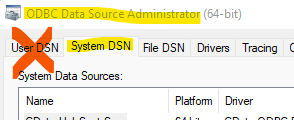ETL+ for ODBC (DSN)
Installation Checklist
ETL+ Connection to ODBC
ODBC driver Requirements for Netsuite
Have your source system’s ODBC driver on the same Windows computer where ETL+ is ( or is going to be installed).
Create or use an ODBC System DSN (instead of User DSN) to your source system

The ODBC driver must have the same 32/64bit build as ETL+
If you haven’t installed ETL+ yet: ETL+ Deployment Instructions.
ODBC DSN file from the ODBC bundle. Follow the instructions at Configuring NetSuite for ETL+
The ODBC bundle installation creates an ODBC DSN that has the necessary parameters preconfigured for the NetSuite instance from where you downloaded the ODBC bundle. Use the info from that DSN to create the DS DSN.
NetSuite Role with proper capabilities
The role must have SuiteAnalytics Connect and SuiteAnalytics Connect – Read All permissions in the Setup subtab.
Adding these permissions to the ODBC user will NOT work. The role itself needs to have the permissions.
Administrator Role cannot be used in the ODBC connection.
NOTES
To retain OAuth credentials Look for your ODBC documentation/configuration on how to retain the OAuth credentials. Example.: Enter the following in CData’s ODBCs → Advanced/Misc/Other:
oauthsettingslocation=C:\Users\Public\oauthsettings.txt
How to Configure ODBC Data Source for Netsuite
Follow the instructions at Configuring NetSuite for ETL+
Login to ETL+ (help here).
To Add a new ODBC source to ETL+
Select Add Source > ODBC on ETL+ Source Objects Panel
Maintaining an ODBC source on ETL+
Right-click the ODBC source > Properties on ETL+ Source Objects Panel
On the ODBC Data Sources page, select the correct ODBC Name from the list.
Can’t find your ODBC? Be sure ETL+ and the ODBC have the same 32/64bit build.
For ODBC connections requiring credentials: double-click the ODBC Name > enter credentials > Connect.
Leave the Alias as is, or customize it as desired.

Example of an ODBC configuration
Click Connect.
NOTES
On the ETL+ Extract, Transform and Load (ETL) Page you should now see tables under the new ODBC source on the left panel.
Update the user and password credentials on the ODBC Data Sources page. OOTB ETL+ templates will be configured with other credentials.
On the ETL+ Extract, Transform and Load (ETL) Page you should now see tables under the new ODBC source on the left panel.
Mapping and Loading Tables
To view tables available from your ODBC source on the left panel, right-click the ODBC source →
Refresh.To map an ODBC table to your data warehouse (ETL Objects),
double-click its nameon the left panel, or right-click on it →Add Table.You’ll now see the table added/mapped to the center panel (ETL Objects).
To preview its data, right-click the table on the center panel →
Preview.To load its data to the data warehouse, right-click the table on the center panel →
Load Now.You might use the right panel (ETL SQL Statement) to customize the SQL statement. In that case, you must use the ODBC driver’s SQL syntax.
Click the
Logicon (top right) to view data load results. Log page help here.
Schedule the Data Load
On the ETL main page, click
Job(top right icon on the center panel).The Job page usually comes pre-configured to your source system(s).
Overview this page’s configuration. On the right panel, feel free to uncheck tables and Tableau extracts that don’t apply to your reporting needs.
Run a Job now (optional): click the
Run Job(play icon) on the left panel.To schedule the data load (optional):
Select a
Job→Job Properties(wrench icon) → configure the schedule panel →Save
Click
Close->Close.
Testing
After ETL+ has loaded your ODBC source tables, this is to check if the data extraction process finished successfully and row count per extracted table matches with your ODBC source tables.
Steps
Login to ETL+ (help here).
On the ETL main page, click the top-right
Logicon. Log page help here.Scroll down on the log page and double-check that no table load failed, and that the row count matches with the source ODBC tables. Following is an example highlighting two tables from a sample ODBC database and their loaded row count.

Example of log from an ODBC source
